In the war for the hearts and minds of videogame enthusiasts, Sony and Microsoft have increasingly turned their attention to the battleground of online services. The stakes are high. It’s becoming clear as this console generation ages that the two companies will come to be defined less by their hardware than by their software; i.e. the experiences they provide users via Xbox Live and the PlayStation Network. Whatever the eventual reality may be for digital distribution, cloud gaming or even the next Sony or Microsoft consoles, these companies’ brand images will largely be represented by their online platforms.

The Escapist recently spoke with Eric Lempel, Director of PlayStation Network Operations, and Scott Austin, Director of Digitally Distributed Games at Microsoft. Through talking to these two generals, it became clear that the founding principles and guiding vision for both services are defined as much by the backgrounds of each company as they are by what gamers actually demand.
Living Room Conquest
At the outset of this generation, the Xbox 360 and the PS3 were both positioned not as mere game machines but as the centers of a digitally connected home entertainment network. Both companies invested in new HD formats to succeed the DVD, Sony had launched its PSP which was interoperable with the PS3 and Microsoft had nothing less than the entirety of the PC market at its disposal, allowing users to create a home multimedia network with the 360 as its beating heart. Sony’s Lempel acknowledges that fulfilling the PS3’s vision as a media hub was an early motivation behind the PlayStation Network: “This was absolutely a major goal and remains one with things like our videos, music player and photo display.” It’s a sensible philosophy given Sony’s success in the HD format war, the multimedia empire under its umbrella and its extensive background in consumer electronics.
Talking with Lempel is an education in the different facets that comprise the PlayStation Network, and perhaps the philosophy of Sony as a whole. Games are an important aspect of the service, but Lempel is always quick to bring the discussion back to the myriad other multimedia features users can access through the PlayStation Network. This includes features like streaming content from the PS3 and basic media management services like music downloads and photo viewers. If, at times, the exact focus of the PlayStation Network seems muddled, it might be because the updates and features associated with it often cast an eye toward possible futures – including taking advantage of the entirety of Sony’s consumer electronics division and becoming a multimedia access point unbound from the PS3 – rather than the present use to which users may want to put it. Sony’s CEO, Howard Stringer, actually said as much in a May interview with Nikkei Electronics Asia: “Next we will be expanding the PlayStation Network to hardware other than the PS3, because the number of PS3 units sold puts a limit on the scale of the network possible.” Lempel speculates that the PlayStation Network might ultimately be the primary platform through which content is delivered to all Sony devices. And considering the vast amount of content Sony represents, through its various television, film and videogame studios, it’s clear this is a significantly advantageous strategy.
Microsoft might also be interested in a broad-reaching influence over all consumer electronics, but one wonders to what extent it’s a priority for the company. When asked about the non-gaming features in Xbox Live, Microsoft’s Austin is more interested in speaking about the company’s recent deals with Facebook and Twitter, in spite of the connection between the Zune HD device currently in development and the upcoming Xbox Live dashboard update. But for Austin, there’s a simpler force that drove the development of Live. “The purpose behind Live is to allow gaming to get back to its original roots,” he says. “Gaming was meant to bring people together.” That message is in line with the primary concern of most Xbox Live users: the games.

The future ambitions for both services may be broad in scope, but for the moment, gamers seem mainly concerned about the kinds of games Xbox Live and the PlayStation Network will offer. Xbox Live’s catalogue is more focused on bringing an arcade-style experience to players. “There are a lot of completely remade and redone games. We try to bring that joy of bumping into an old friend,” Austin says. “At the very same time we are trying to come up with innovative games. Look at Castle Crashers last year.”
The PlayStation Network publishes its share of arcade-style games, but Sony has also invested heavily in finding games that, to twist Austin’s metaphor, are like meeting a new friend. “We wanted to give people an alternative look at games,” Lempel says. “There were all these developers that Sony was interested in working with but it just wasn’t feasible to give their games a full retail release until PSN was available.” The fruits of these labors have resulted in games like Everyday Shooter, the PixelJunk series and Flower.
Lempel paints Sony as an advocate for the cause of indie developers. He says of Sony’s strategy, “We have key members of our team that go out and seek these developers.” He also explains that Sony provides financial and technical assistance to get these games into commercial form. “We have what we call a pub fund set up to help these small developers create their game,” Lempel says. “For example, Burn Zombie Burn is a product of that fund, and it’s been very successful for us.”
The Digitally Distributed Future
As far as when – if ever – all games will be delivered digitally, both Austin and Lempel are reluctant to offer any predictions. “Retail experience is still very strong for us and [a] major part of the strategy,” Lempel says. “We still support physical media until consumers do otherwise. It’s going to be a matter of tracking where consumers are in their habits.” Austin echoed Lempel’s sentiments. “The industry will get there when the consumers indicate a willingness for it,” he says. In other words: It’s up to you.
Yet despite these declarations in support of physical media, the evidence strongly suggests both companies are laying the groundwork for a future in which all games will be distributed digitally. Microsoft announced at this year’s E3 that it would be releasing games from the Xbox 360 back catalog through Xbox Live this August. “We just see it as a way to give consumers choice,” says Austin. “There are a lot of titles that are difficult to get.” But behind this relatively innocuous statement lies the fact that Microsoft is using digital distribution to fill a gap currently occupied by the used games market – another step toward replacing brick-and-mortar retail outlets with downloads.

For its part, Sony has already experimented with full-scale digital distribution, famously releasing Warhawk in its entirety through the PlayStation Store. However, such releases have been few and far between, with no concerted strategy on the order of Microsoft’s latest announcement. Sony’s first major commitment to digital distribution as a primary means of software delivery is coming instead in the form of the PSP Go, which will be the company’s first entirely network-based device. Lempel stressed that it was a combination of consumer feedback and the flexibility that the platform offers that drove the decision to release a version of the PSP designed solely around digital distribution.
Divergent Evolution
Yet in spite of each service’s strengths, they both have weak spots. Regarding the PlayStation Network, it’s clear the scope of services offered to users is overwhelming. Lempel acknowledges this. “There’s a lot we need to do to fully educate users,” he says. “People may not know about features like Home interoperability … and the ability to stream content from PS3.” He also mentions the device’s photo and music managers, which many users may not be utilizing to their full extent.
Confronted with the issue of Xbox Live’s baggage, Austin notes that “one of the big things I see is that people don’t fully understand the [game] license model that we have. It’s robust. With Xbox Live, license information is stored in the cloud. Games can be downloaded to your profile. As digital distribution increases, it will be important that people understand this.”
For its part, Sony’s network comes across as being much more ambitious than Live – not because it strives for higher quality, but because it has become nothing less than the digital flagship for all of Sony’s initiatives. While the PlayStation Network may have started as a network for gamers, the expense of developing it and the desire to fully recoup these costs have forced the network into a much larger role. As has, perhaps, the failure of the PS3 to establish a larger beachhead in American homes.
The proliferation of Windows in that same space means that Microsoft has the luxury of compartmentalizing Xbox Live as something specifically for videogame players. Also, Microsoft’s relatively limited presence in the consumer electronics space means they need not spend as much time focusing on compatibility issues between different devices – not yet, anyway. This ability to focus on a single core audience has paid off in a service that’s exceedingly clear about what it delivers: games first and foremost, customization for the experience surrounding those games and some additional multimedia content. Meanwhile, Sony offers games, a secondary user experience in the form of Home that’s barely been explored, multiple uses for the PS3, ever changing ways in which the PSP can interface with it and the unexplored territory of the PSP Go as a purely network-based device – a wider array of choices, but one that nevertheless gives the Playstation Network the appearance of being adrift.

It’s easy to see how Microsoft’s Xbox Live will define the company’s identity. It’s less clear how Sony will continue to distinguish the PlayStation Network in gamers’ eyes. Sony’s user interface speaks to the company’s hardware neutrality, and it works well in the sense that navigating the service on a PSP or PS3 are one in the same, but it isn’t designed for a specific audience. The Xbox Live experience is decked out with friendly avatars that will soon be very customizable, and content is arranged around pages, not unlike a web portal. All of which smack of being designed explicitly to appeal to a certain type of consumer, whose demands Microsoft seems to fully understand. The PlayStation Network is utilitarian; indistinguishable from – albeit as easy to navigate as – a menu on a digital camera. Perhaps this ubiquity will, in the long run, work to their advantage.
While it would appear Microsoft has the upper hand for the moment in the battle for console dominance, as the war continues and becomes increasingly about how our videogame systems (and our games) interact with the rest of our lives, it remains to be seen if that will last. One thing is for certain, however: With such an astounding array of advancements coming down the pipe – from both companies – gamers themselves will most likely be the ultimate winners.
Tom Endo still thinks Teletext should be the preferred digital distribution network of choice.










Published: Jul 28, 2009 12:29 pm